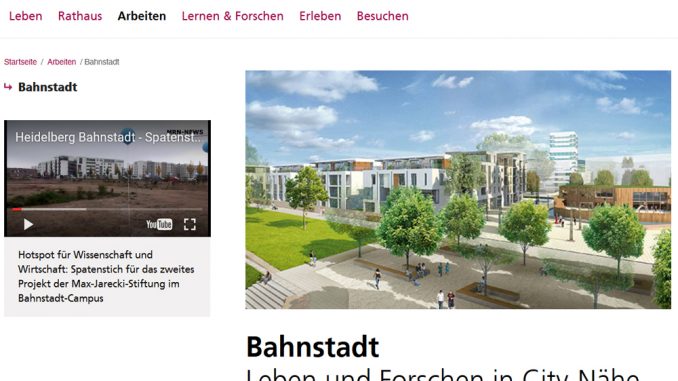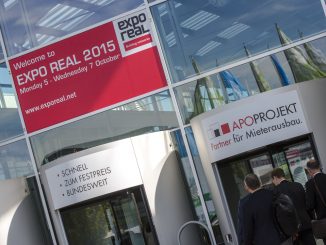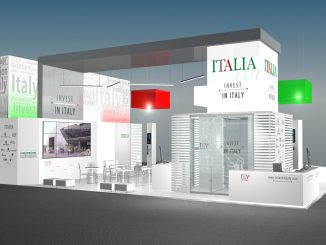
An ‘innovation park’ for the digital age… new residential neighborhoods… an entirely carbon-neutral city district… Heidelberg and its partners will be presenting no less than two major urban development projects at the Expo Real trade show in Munich (4-6 October 2016): the conversion of the city’s former US Army sites, and ‘Bahnstadt’, an entire new city district. When the US Army left Heidelberg, it freed up 180 hectares of land in the world-famous ‘city of science’. This created a once-in-a-lifetime opportunity for Heidelberg. Meanwhile, the city’s new 116-hectare Bahnstadt district, with its 100% ‘passive house’ buildings, is already admired around the world as a zero-emissions district. Bahnstadt continues to grow fast. Now, aided by a multidimensional model of the city, Heidelberg will be showcasing the latest developments in these two major projects at the Expo Real trade fair, at the joint stand of the Rhine-Neckar Metropolitan Region.
“Heidelberg is in a period of transition that, over the next decades, will transform the look of the city. Our Bahnstadt and conversion projects are both hugely ambitious in terms of the sheer amount of land involved. But the demand for housing and premises for start-ups and established businesses in Heidelberg is equally huge, so the new districts will help to meet this demand. Heidelberg’s outstanding universities, research institutes and hospitals attract highly-qualified people from all over the world, and more and more companies are looking to move here as well – provided they can find suitable premises,” said Heidelberg’s Mayor, Dr. Eckart Würzner.
Conversion of former US Army sites
A total of 180 hectares of land in Heidelberg – some of it right in the heart of the city – will be converted to civilian uses in the near future. To decide how the redeveloped sites should look, the city has launched an intense ‘dialog-based planning process’ involving the city administration, planners, local policy committees, and the general public.
So far the plans for the Mark Twain Village/Campbell Barracks area (43 hectares) are the most advanced. The City of Heidelberg and MTV Bauen und Wohnen GmbH & Co. KG (MTV) acquired a large portion of this area from the German Institute for Federal Real Estate (BImA) on January 1, 2016. MTV – an alliance of cooperative banks and housing associations, including the municipal housing association GGH – is to invest around 320 million euros in building and renovating approximately 1,300 apartments on the site, including 70 percent affordable housing, in line with City of Heidelberg housing policy. The first tenants have been living there since summer 2016. At the heart of this residential district will be a local shopping center, other retail premises, a vocational school, childcare facilities, a community center, and a flagship cultural project: the Mark Twain Center for transatlantic relations.
The historic buildings at Campbell Barracks – most of which are listed as historic monuments – will accommodate, for example, a ‘praxisHochschule’ private vocational college, the criminal investigation department of Heidelberg’s police force, and the Kulturhaus Karlstorbahnhof cultural center. A new center for cultural and creative businesses is also planned, as are a range of other commercial premises for office-type businesses.
At Patton Barracks, ‘Heidelberg Innovation Park’ (HIP) is taking shape – a hotspot for companies in the IT, bioinformatics, digital media and design sectors. One of the first milestones for HIP will be the opening of a business development center for organic electronics. A new sports and cultural arena seating up to 5,000 people is also planned. Zürich architects Hosoya Schaefer, who emerged as the winner of the urban design ideas competition for this area, are responsible for the overall planning.
The old US Hospital site (9.3 hectares) in the south of the city’s Rohrbach district will offer a mix of residential, commercial, cultural and educational facilities, with housing taking top priority. The winners of the urban design ideas competition for the US Hospital were the studios Hähnig Gemmecke (Tübingen) and Fromm (Dettenhausen), with their plans for roughly 600 apartments and a 7,700 square-meter park. Intensive talks are currently underway with the charity Lebenshilfe Heidelberg and the Montessori Center. The non-profit Collegium Academicum is also planning a hall of residence for 200 students there, which will include an area for meetings and seminars.
Plans for Patrick Henry Village (PHV), a 97.2-hectare area in the city’s Kirchheim district, are being drawn up as part of Heidelberg’s international building exhibition (IBA). This preliminary planning stage, called ‘planning phase zero’, runs until spring 2017 and draws on input not just from local specialists and the general public, but also from leading international urban design experts. The aim is to generate ideas and suggestions that will enable the area to function as a prototype ‘knowledge city of the future’. By the start of 2017, four thematic scenarios will have been developed, based on the four overarching topics Science & Business, Mobility & Infrastructure, Education & Knowledge, and Urban Metabolism.
Bahnstadt
Bahnstadt is a 116-hectare site formerly occupied by a railway shunting yard. It is the biggest residential area in Europe to be built purely to the ultra-eco-friendly ‘passive house’ standards. The site will be populated with a classic Heidelberg-style mix of high-quality housing, scientific institutions, and businesses. Over 3,000 residents have already moved in. Hi-tech businesses, a university, a hotel, childcare facilities, a cultural and community center and various retailers have also set up in the new district. And two more major projects have now been launched in Bahnstadt: ‘B³’ – a complex consisting of an elementary school, nursery and community center – and a multiplex cinema. Other landmark projects are scheduled to start in 2016: SkyAngle, a modern office and laboratory building, and the Colours complex, which offers spaces for research, work, shopping, living and leisure. Ultimately Bahnstadt will have 5,500 residents and provide 7,000 jobs. The district will be connected to the rest of the city by two tram lines and a series of bicycle-friendly streets.
“Bahnstadt is an attractive location for service and science businesses, so commercial premises are in big demand. The breadth of our focus – encompassing homes, research, work and leisure – means that diversity is truly built into the fabric of the district,” said Peter Dohmeier, Executive at Entwicklungsgesellschaft Heidelberg.




 - Creocom - Via del Buon Ricovero, 10 - 00189 Roma - p.iva 07881611003 -
- Creocom - Via del Buon Ricovero, 10 - 00189 Roma - p.iva 07881611003 -